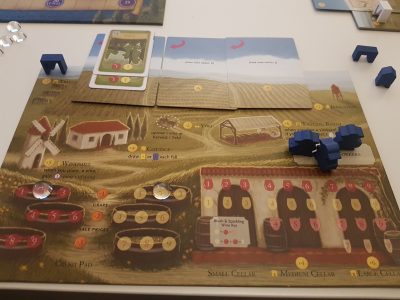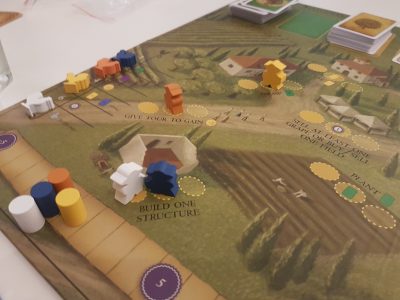Viticulture Essential Edition is a worker placement game from Jamey Stegmaier, the man behind the insanely popular board game Scythe. This version of the game combines elements of the original game with the Tuscany expansion to create one “essential edition”. Viticulture is a board game and a word which revolves around the science, production, and study of grapes and wine! It handles everything that occurs at a vineyard from the growing of grapes, through harvesting, to storing and selling aged bottles of wine. The game is incredibly thematic with each and every action possible to players being real-world steps in the wine making process. So, how does it play? Let’s find out!
The game starts off with each player receiving a unique mama and papa card. These aren’t hugely different but give each player slightly different starting items and cards. The papa cards also offer players their first of many choices to make. The mama cards offer a set amount of worker meeples and a selection of the four card types. The papa cards offer a Grande worker meeple and then give a choice between more money and depending on the card a structure or addition worker. This means everyone starts in slightly different ways and can see game plans needing to be tweaked.
As with real life there are 4 seasons, with most of the game taking place in the two most people talk about, Summer and Winter. Spring starts of each round with players selecting turn order. The later you commit to going in the turn order, you’ll be awarded with a differing advantage such as a visitor card or 1 Lira all the way up to a bonus temporary worker meeple, for committing to guaranteed last.
Turn order can be very important towards the conclusion of the game, seeing players going for guaranteed first. Though it has no bonus securing the actions needed first, without spending the Grande meeple, can be extremely beneficial. Nevertheless, near the beginning players will jump around more trying to go early on while getting bonuses to help them out.
Summer is the first major season. This is where players will take it in turns to place meeples to perform actions. When 2 players are playing only one worker slot for each action is available, with 3-4 a secondary slot with a bonus becomes available and with 5-6 all three slots are useable for each action. Summer actions include: drawing grape cards, planting vines, building structures, playing summer visitor cards and giving vineyard tours. Player continue to place workers in turn order until they all choose to pass, saving unplaced meeples for Winter.
Next up is Autumn, or Fall, where players gain a visitor card. The choice of whether it is a Summer or Winter visitor is up to the player. Then, it is straight into the business end of the year, Winter. Actions in winter are more orientated towards getting or getting rid of wine. This include: Harvesting fields, making wine, taking wine orders, playing winter visitors, training additional workers for future years and completing wine orders.
There is a lot going on in Viticulture, all neatly wrapped up in wonderful fruity theming. After winter ends if anyone has reached 20 victory points the game is over. Otherwise, players claim back their spent workers, earn any ongoing income from previously completed wine orders, discard down to 7 cards and then if possible grapes and wine age. This process sees grapes or wine increase in value by sliding the tokens along the trackers on the player mats.
The maximum grape value is 9 and these are available to players from the start of the game. Wine, on the other hand, can only be aged if a player has the right size cellar. For example, the smallest cellar only holds red and white wine up to the value of 3. Value 3 wines therefore cannot be upgraded further by aging until a medium cellar is built. This aging process is key to fulfilling some of the high-end orders. So, one strategy for players is to get a lot of grapes and wine made early and wait for them to age.
When it comes making the wine with harvested grapes, players taking the make wine action can make up to two wine tokens. They do this by sliding across a token from their crush pad to the identically numbered and coloured number in the wine cellar. This works for the standard red and white wines. Blush wines, which require a mix of 1 red and 1 white grape, and Sparkling wine, which requires 2 red grapes and one white add the numbers of the grapes together to become the expensive luxury wines.
Points can be earnt in a variety of ways. The most common is completing wine orders. These will feature wine or wines of various values. When a player uses the worker placement slot to fulfil an order they trade if they trade in the correcting aged, or better, wines they get a set amount of points. Wine isn’t the only ways to gain points the turn order tracker has 1 victory point available and some action spaces for workers come with a bonus victory points in games with at least three players. Select visitor cards can also be played to convert wine or Lira into points.
Viticulture is all about giving players choice. From the available actions on the board there is always something that would be beneficial. Key to giving players choice on each and every turn is the Grande meeple. This supersized meeple enables players to choose an action even if the action spot is taken by a meeple. While this doesn’t completely take away the aspect of worker placement games where blocking off can be a legitimate system, it does massively limit this kind of direct confrontation. This certain seems in keeping with the pleasant, family wine business feel. To balance the Grande meeple, it can only be used once per year so when and where to use it is a big choice for players.
The distribution of the wine order cards does introduce an element of luck to the game that does slightly, and only slightly, detract from the game. Worker placements should be won and lost on the choices made but many fall down on the cards drawn. Thankfully, in Viticulture these orders are less impactful due to the visitors. Visitors can help players do different things from helping to build structures cheaper, gain grapes or sell wines. They really help to shake the game up and with a constant flow of them from Autumn, on top of the opportunities to pick visitor cards up in Summer and Winter, plenty of them will be played throughout the game.
Coming from playing Scythe I had high expectations for Viticulture’s components and I was not disappointed at all. Each player has some carefully designed meeples and structures made from wood. These are all instantly recognisable from their shape, making it quick and easy to read the player mats. The gameboard features a beautiful illustration of old world Tuscany that just ups the strength of the game’s theming. There is an elegance which flows through the illustrations that continue from the main board to the player board and delicately seeps into the soul of the game.
There is a slight issue if you are far behind as you can visibly see on the point tracker if you’re in contention. In the majority of the games of Viticulture it has been close to the wire, with the victor only pipping others to the 20-victory point post by a couple of points. This drives the excitement as each player is calculating, plotting and planning until the very end. One game does spring to mind, where a player came out of nowhere with perfectly ages grapes to zoom up the point tracker. This out of the blue winning is all part of the design. Alas, I couldn’t help feeling the game had ended abruptly before I could react. As everything is visible at all times, grapes and wine wise, it should have been no surprise. So, just make sure to pay attention to what others have, especially late game.
Overall, Viticulture is like a hopeless romantic worker placement game with a glass of wine. The love and affection that has been shown to the game shines out from the beautiful illustrations, through to the stunning components that are almost to be expected from Stonemaier Games. While there is a lot going on it is easily manageable and with the real-world vineyard theming each action makes logical sense. Those whom love to block players off and try to force opponents into sub-optimal moves will dislike the Grande meeple. However, I enjoyed this less aggressive worker placement feel. With aspects such as trading turn order for resources and the extent of the options available to players, it is easy to say Viticulture is one of the best worker placement games available!
[Editor’s Note: Viticulture Essential Edition was provided to us by Esdevium Games for review purposes. The game is currently available on 365 Games for £39.39. It is also available from local UK board game stores, find your local store here]





